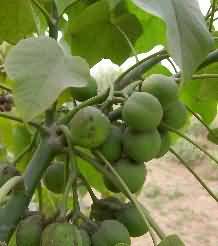रतनजोत या जटरोपा की खेती
 Jatropha curcus,also known as Ratanjyot or Jangli erandi, is a drought-resistant perennial plant which grows almost anywhere- in marginal/ poor soil even on gravelly, sandy and saline soils. It can thrive on the poorest stony soil. It can grow even in the crevices of rocks.
Jatropha curcus,also known as Ratanjyot or Jangli erandi, is a drought-resistant perennial plant which grows almost anywhere- in marginal/ poor soil even on gravelly, sandy and saline soils. It can thrive on the poorest stony soil. It can grow even in the crevices of rocks.
It is a small tree or shrub with smooth gray bark, which exudes a whitish colored, watery, latex when cut. Normally, it grows between three and five meters in height, but can attain a height of up to eight or ten meters under favourable conditions.
It has large green to pale-green leaves, alternate to sub-opposite, three-to five-lobed with a spiral phyllotaxis. The petiole length ranges between 6-23 mm. The inflorescence is formed in the leaf axil. Flowers are formed terminally, individually, with female flowers usually slightly larger and occurs in the hot seasons.
 Fruits are produced in winter when the shrub is leafless, or it may produce several crops during the year if soil moisture is good and temperatures are sufficiently high. Each inflorescence yields a bunch of approximately 10 or more ovoid fruits. A three, bi-valved cocci is formed after the seeds mature and the fleshy exocarp dries. The seeds become mature when the capsule changes from green to yellow, after two to four months
Fruits are produced in winter when the shrub is leafless, or it may produce several crops during the year if soil moisture is good and temperatures are sufficiently high. Each inflorescence yields a bunch of approximately 10 or more ovoid fruits. A three, bi-valved cocci is formed after the seeds mature and the fleshy exocarp dries. The seeds become mature when the capsule changes from green to yellow, after two to four months
Once grown the crop has a fifty years of life. Fruiting can take place in this plant in two years. It yields five-twelve tonnes per hectares oil seeds and produces two -four tones of bio-diesel
Growing time of Jatropha
Nursery raising time:Feb- March, Sep- October
Trasplanting of saplings:February - April , In monsoon months
Direct seeding sowing: After good rainfall
Direct planting by cuttings:Two month before monsoon
Manuring time:On trasplantation and after one year
Pruning time: March-May
Flowering time: May - September,
Fruiting time:July- November
Harvesting time: August- December (North India)
Jatropha plant produces seeds with an oil content of 37%. The oil contains 21% saturated fatty acids and 79% unsaturated fatty acids.There are some chemical elements in the seed which are poisonous and render the oil not appropriate for human consumption.
Uses of Jatopha Curcus (Ratanjyot)
- Non-edible vegetable oil of Jatropha curcas has the requisite potential of providing a promising and commercially viable alternative to diesel oil since it has desirable physicochemical and performance characteristics comparable to diesel. Cars could be run with Jatropha curcas without requiring much change in design.
- The oil is used as an illuminant without being refined and it burns with clear smoke-free flame.
- Oil has a very high saponification value and is being extensively used for making soap in some countries.
- The latex of Jatropha contains an alkaloid known as "jatrophine" which is believed to have anti-cancerous properties.
- It is also used as an external application for skin diseases and rheumatism and for sores on domestic livestock. In additon, the tender twigs of the plant are used for cleaning teeth, while the juice of the leaf is used as an external application for piles. Finally, the roots are reported to be used as an antidote for snake-bites.
- The bark of Jatropha curcas yields a dark blue dye which is used for colouring cloth, fishing nets and lines.
- Jatropha oil cake is rich in nitrogen, phosphorous and potassium and can be used as organic manure.
- Jatropha leaves are used as food for the tusser silkworm.
Jatropha curcus or Ratanjyot, can prove itself a miracle plant by turning waste land into a moneymaking land. It can help to increase rural incomes, self-sustainbility and alleviate poverty for women, elderly, children and men, triabal communities, small farmers.
